
The Ninth Fort is a stronghold in the northern part of Šilainiai elderate, Kaunas, Lithuania. It is a part of the Kaunas Fortress, built in the late 19th century. During the Soviet occupation, the fort was used as a prison and way-station for prisoners being transported to labour camps. After the occupation of Lithuania by Nazi Germany, the fort was used as a place of execution for Jews, captured Soviets, and others.

Kaunas is the second-largest city in Lithuania after Vilnius, the fourth largest city in the Baltic States and an important centre of Lithuanian economic, academic, and cultural life. Kaunas was the largest city and the centre of a county in the Duchy of Trakai of the Grand Duchy of Lithuania and Trakai Palatinate since 1413. In the Russian Empire, it was the capital of the Kaunas Governorate from 1843 to 1915.

The Aleksotas Eldership is an eldership in the southern section of the city of Kaunas, Lithuania, bordering the left bank of the Nemunas River. Its population in 2006 was 21,694. The elderate borders Vilijampolė and Centras in the north, Šančiai and Panemunė in the east, Garliava in the south as well as Akademija in the west.

Žaliakalnis is a neighbourhood and eldership in Lithuania's second largest city, Kaunas. Žaliakalnis is located north of the old town and the city center area, between the Neris and Girstupis valleys. It is one of the largest residential areas in Kaunas, with a population of 38,480 in 2006.

The Centras Eldership is an Eldership in the city of Kaunas, Lithuania, based on two neighbourhoods of Kaunas - the Old City and the New City. It lies at the confluence of two major Lithuanian rivers, the Nemunas and the Neris. The borough borders Žaliakalnis in the north, Šančiai in the east, Aleksotas in the south and Vilijampolė in the west.

Eiguliai is neighborhood in the city of Kaunas, Lithuania. Eiguliai elderate encompass Eiguliai, Kleboniškis and part of Kalniečiai neighbourhoods. Elderate itself is located on the left bank of the Neris River. The distance from Eiguliai neighborhood to Kaunas centre is approximately 6 km. The settlement was a small village until it was incorporated into Kaunas in 1959 and a residential microdistrict was built in 1979. The 7th Fort of the Kaunas Fortress are located in this eldership. The borough borders Dainava in the east, Žaliakalnis in the south, Vilijampolė and Šilainiai in the west and Domeikava with Lapės in the north. It has 40,453 inhabitants which represent 13.82 % of the population of Kaunas city municipality.
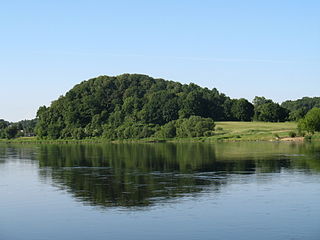
Napoleon's hill, actually Jiesia (Pajesys) hill fort mound is located in Kaunas, Lithuania, on the left bank of the Nemunas, between the Panemunė and Railway bridges. It is 63.3 meters high. Since the 19th century, it has been named Napoleon's hill.

Žaliakalnis Funicular is a funicular railway in Kaunas, Lithuania. Built in 1931, it is the oldest funicular in Lithuania and is among the oldest vehicles of such type in the world still operational. The funicular is made of a wood-paneled coachwork and climbs 142 metres (466 ft) up from behind the Vytautas the Great War Museum to the Basilica of the Resurrection.

Gričiupis is a neighborhood of the Lithuanian city of Kaunas, located on the right bank of the Nemunas River. It has elderate status, and is the smallest elderate in the city. Its administrative status as an elderate was established in 2005, when it was detached from Dainava elderate. In 2021 its population was 23,894 in an area of 3.81 square kilometers.

Panemunė Eldership is an eldership in Kaunas County, Lithuania, encompassing Kaunas neighbourhoods of Panemunė, Vaišvydava, Vičiūnai, and the village of Rokai. Located on the left bank of the Nemunas River, it was formally incorporated into Kaunas in 1931. It occupies 24.78 hectares with 22,140 inhabitants.
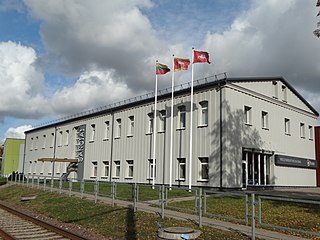
Šančiai is an elderate in the Lithuanian city of Kaunas. It is located on the meandering right bank of the Nemunas River. Šančiai itself are divided into Žemieji Šančiai and Aukštieji Šančiai neighborhoods. Names come from their adjacent locations. Žemieji Šančiai is located on the Nemunas river valley, while Aukštieji Šančiai is located on the hill above the valley. Its entire elderate population of 2007 was 23,237.

Vilijampolė is a neighborhood in the city of Kaunas, Lithuania, located on the right bank of the Neris River and the Nemunas River, near their confluence. Part of a larger Vilijampolė elderate which consists of Vilijampolė, Lampėdžiai, Panerys, and Veršvai neighorhoods, and covers 1,720 hectares with population of 23,687 people.

Ąžuolynas is a public park in Lithuania's second largest city, Kaunas, in the Žaliakalnis elderate. The park covers about 84 hectares and is the largest urban stand of mature oaks in Europe. Vydūnas Alley serves as the park's northern border. It is a popular recreational destination for the inhabitants of Kaunas. Most of its trees are oaks ranging in age from 100 to 320 years old, but it also holds linden, birch, and maple trees.

Petrašiūnai Cemetery is Lithuania's premiere last resting place formally designated for graves of people influential in national history, politics, arts, and science.
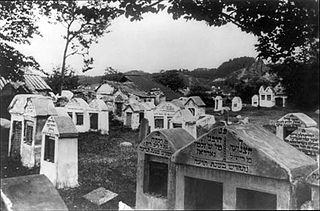
The Jewish cemeteries of Vinius are the three Jewish cemeteries of the Lithuanian Jews living in what is today Vilnius, the capital of Lithuania, which was known to them for centuries as Vilna, the principal city of the Grand Duchy of Lithuania and the Pale of Settlement of the Russian Empire. Two of the cemeteries were destroyed by the Soviet regime and the third is still active.

Kaunas Fortress is the remains of a fortress complex in Kaunas, Lithuania. It was constructed and renovated between 1882 and 1915 to protect the Russian Empire's western borders, and was designated a "first-class" fortress in 1887. During World War I, the complex was the largest defensive structure in the entire state, occupying 65 km2 (25 sq mi).
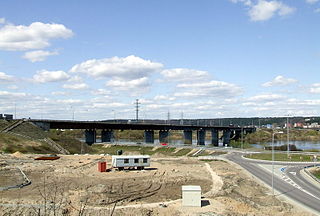
Lampėdžiai Bridge is a bridge in Kaunas, Lithuania. It crosses the Nemunas River to connect Marvelė in Aleksotas district and Lampėdžiai neighbourhood in Vilijampolė elderate. The bridge is 446 metres in length. It carries four lanes of automobile traffic, with two lanes in each direction. The bridge, completed in 1997, is also named after a Lithuanian roadman Česlovas Radzinauskas. Lampėdžiai Bridge is a part of Via Baltica and A5 highway of Lithuania, and western bypass of Kaunas.
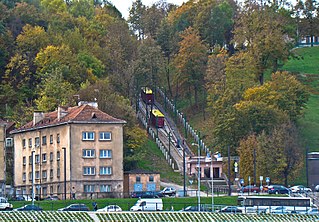
Aleksotas Funicular is a funicular railway located in Aleksotas elderate of Kaunas, Lithuania. The funicular constructed on the right bank of the Nemunas River was officially opened on 6 December 1935. The track of the Aleksotas funicular remained unchanged. The track has a separation in the centre of the track for carriages to pass. Special automatic brakes were installed in carriages not to let them run down in case of cable damage. The length of funicular is 132.9 metres (436 ft), gradient - 18 degrees. Authentic traction equipment, including the genuine pre-war wagons, wooden seats, and stop platforms of the funicular are still used.
Ramybė Park is a public park in Kaunas, Lithuania, established in 1959 in the territory of the Kaunas City Old Cemetery that was also known as the Carmelite Cemetery. The cemetery was established in 1847 and became the main city cemetery with sections for four different religions – Roman Catholics, Eastern Orthodoxs, Lutherans, and Muslims. During World War I and subsequent Lithuanian Wars of Independence, Russian, German, and Lithuanian soldiers were buried in the cemetery. During the interwar period when Kaunas was the temporary capital of Lithuania, many famous people were buried there and several buildings were constructed on the cemetery's territory. In 1930, a monument to fallen Lithuanian soldiers with a tomb of an unknown soldier was unveiled. Around the same time, a tradition to honor fallen soldiers on the All Saints' Day began.


















